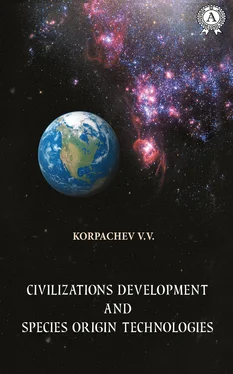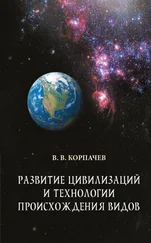Nowadays it has become apparent to many palaeontologists that the fossils do not contain any alleged transitional forms at all. No transitional links’ sequential series, as well as individual random transitional forms, have ever been found among the minerals. At the same time, long periods of the same organisms’ stable existence within a relatively short time gave way to the new species’ rapid formation; they appeared completely formed in the fossil record. Despite the lack of continuity in the fossil record, which is strong evidence to oppose the theory of the new species’ formation through gradual evolutionary changes, fossil evidences do confirm the progressive increase in the organisms’ complexity.
The evolutionary theory supporters, in an attempt to explain the lack of transitional forms in the geological record, put forward the «discontinuous equilibrium» (punctuality) hypothesis, according to which evolution is carried out at an uneven rate with long periods of stability, with rapid qualitative leaps alternating the stability period that occur in small populations of organisms. Due to this, some new species arise very quickly, and the intermediate links are practically not found in the geological record because of their minor quantity.
These evolutionary sequence «leaps» originated the term «spasmodic evolution».
The evolutionary theory supporters believe that the paleontological data’ incompleteness can be explained by the fact that dead organisms were quick to decompose or were eaten by carrion-feeding animals. But then a natural question arises: why did this happen to transitional forms and did not affect existing species?
Charles Darwin and Louis Dollo formulated the «law of irreversibility of evolution,» according to which species cannot return to the state of their ancestors. At the same time, the examination of the fossilized remains of the Gastrotheca guentheri species frogs stated that they lost their lower teeth 230 million years ago, but the teeth reappeared about 20 million years ago. Thus, this does not fit the proposed concept.
Cases of the useful genes’ loss are also inconsistent with the evolutionary theory. Such a phenomenon was found among the stick insects’ winged species evolved from the wingless ones, which, in turn, had ancestors with wings. This case of the complex trait loss and its subsequent restoration in the evolutionary development may indicate that in this case the genetic information is regulated not by living conditions and selection, but by purposeful and thought-out changes. The giant forms of almost all types of contemporary living creatures have been discovered among the fossils. Mammals were often twice the size of their modern representatives: turtles, bears, camels, panthers, pigs, rhinos, elephants, tigers, wolves, birds and insects. The very fact of such giant fossils’ existence contradicts the evolutionary theory according to which animals evolve into more complex forms with an increase in their size.
It is also difficult to explain from the point of view of the evolutionary theory why the mental abilities improvement was accompanied by the loss of the ability to regenerate organs, the ability to detect radiation and earthquakes, as well as many other useful properties that could be improved along with the development of thinking. But that did not happen. If regeneration is the result of evolution, then why the ability to regenerate organs has been lost? It seems to be a necessary process that contributes to the preservation of the species. The inexplicable appearance of organs with a complex structure, such as eyes is one more weak point of the evolutionary theory. Ch. Darwin stated that the sensitive to light organs which even the simplest creatures possess, can be improved, beginning with simple pigment spots up to the facet eyes of insects or the human eye’s complex high-precision visual system. This assumption does not provide a description of each intermediate stage formation and why each of the stages, taken separately, is useful for the survival of the body. It is also fundamentally impossible to explain the emergence of such complex organs as the liver or brain, or complex behavioral programs such as bee dancing − since these objects and phenomena favour survival only when they are fully «packed» and individual minor changes do not lead to any evolutionary advantage and therefore could not gain a foothold.
The supposed evolutionary transition of living beings from water to land is also doubtful. There are a number of facts to testify the impossibility of such a process. Organisms that lived in water and subsequently left it, should have had developed muscles and skeleton capable of withstanding the weight of the body as well as providing energy for movement. A major part of terrestrial creatures consume up to 40
% of energy on the transfer of their bodies. In addition, it is pointless to try to explain the complex of organs and internal secretion substances involved in this process by random mutations. Besides, aquatic and terrestrial inhabitants have different temperature regimes. The temperature conditions are unstable and fluctuate on land, whereas the temperature of the habitat is changing slowly and insignificantly in water. Earth creatures have the developed metabolism system, due to which a relatively constant body temperature is preserved, regardless of the ambient temperature changes. Thus, aquatic animals are equipped with physiological mechanisms that are designed for life in conditions of constant temperature, and for transition to dry land they had to transform the body quickly, by means of the protective means of body temperature regulation’s use with the environment state taken into account. It is doubtful that random mutations could lead to such serious and highly organized changes. Therefore, there is every reason to believe that land animals were created on the basis of aquatic organisms by creating special systems for existence in the atmospheric environment. For example, aquatic animals are capable of filtering and excreting excess chemicals, particularly ammonia, while land representatives use a well-developed system of kidneys, excreting toxins in the urine consuming as little liquid as possible of the for cleaning the body.
If, according to the evolutionary theory, species had been evolving and adapting to the environment for millions of years, the question arises: why the humoral regulation of living organisms which have been living in the atmospheric environment for millions of years has neither reduced nor modified? The existing system of humoral regulation, provided by the system of blood vessels and heart, is adapted to the aquatic environment and is imperfect and vulnerable in the atmospheric one. At the same time, despite the new species’ occurrence on land, the principle of regulation has not been changed. If evolutionary processes can contribute to significant changes in the living organisms’ properties, adapting them to the conditions of the environment, why not a single species capable of existing in the atmospheric environment regardless of the water supply has ever occurred within millions of years? Why has the water dependency not disappeared? The humoral regulation of the body should have disappeared and been replaced by other regulation system more adapted to the atmospheric environment when animals moved to land. However, this did not happen on land and functional system has not been changed.
If animals, including humans, have been existing on the surface of Earth for a huge period of time, why are many physiological biorhythms adapted to the lunar rhythms that most aquatic animals follow?
Dolphins are known to communicate in the infrasonic range. If for them, the aquatic animals, it is understandable, it becomes rather incomprehensible why elephants living on land communicate in the same range? It contradicts the evolutionary views of natural selection. The development of moral qualities inherent to a human also contradicts the evolutionary worldviews. If a human has descended from a wild ancestor, then the one who survives within the natural selection should not have such categories as conscience and morality as they should have disappeared in the process of evolution. A conscientious human would not have a chance to survive. Meanwhile, this concept remains in humans, although not yet sufficiently fixed as an echo of the animal state. A human has the opportunity of daily choice between good and evil, and society analyzes his choice and assesses this choice on the basis of moral considerations formed on the grounds of mind, but not evolutionary principles. According to Kant, this is proof of the Creator’s existence.
Читать дальше












